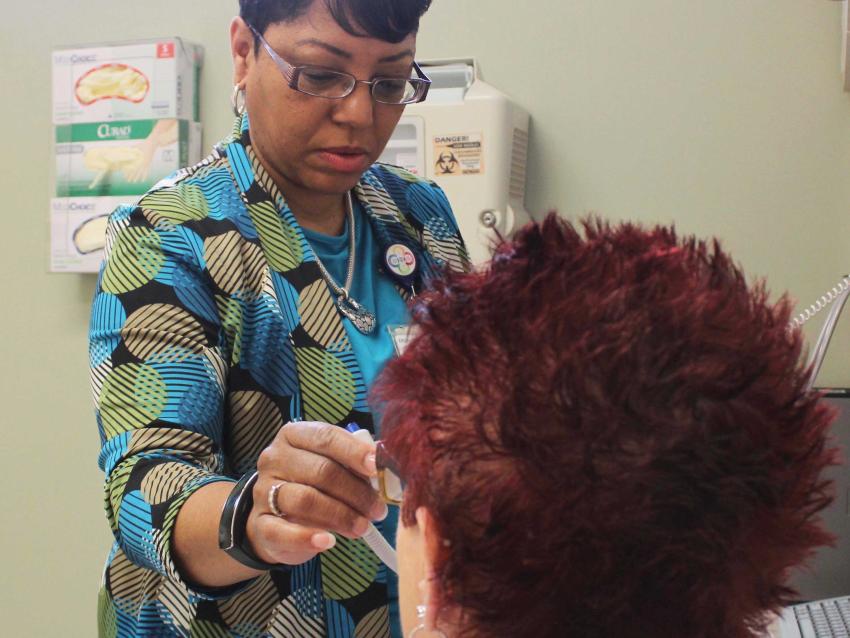
Polk-Dalton Clinic Ensures Compliance, Improves Satisfaction for Chronic Pain Patients
By Elizabeth Adams
Opioid addiction is a complex medical disorder that impacts the entire nation, but much of the problem is condensed to disparate regions of Kentucky. This is the first installment of a series of articles highlighting the work of University of Kentucky researchers and UK HealthCare medical providers who are making progress toward solutions to the epidemic in our state and at large. #UK4KY
LEXINGTON, Ky. (July 12, 2016) — Playing team sports brought Gayle happiness and health throughout her life. But skidding into home plate and sprinting across tennis courts through the years caused the gradual deterioration of cartilage in her knee and ankle joints.
At age 64, Gayle experiences pain in her knees and ankles about six out of seven days a week. Five years ago, she underwent multiple surgeries to repair tendons in her knees and ankles, but complications post-surgery exacerbated her pain.
Gayle has accepted chronic pain as a fact of life — the new normal — but she won’t let it slow her down. Raising her pre-teen granddaughter, she spends most summer days driving a bunch of girls to dance competitions and cheerleading practices.
“I’m their designated Uber driver,” Gayle said with a smile.
On a Friday morning in June, Gayle answered a series of questions about her levels of pain tolerance, thoughts and moods, and her prescription behaviors during her Chronic Opioid Analgesic Therapy (COAT) Clinic appointment at the UK HealthCare Polk-Dalton Clinic. She knew what to expect during her the monthly prescription check-in, so getting her pain medication filled was a fluid and familiar process. After a series of questions, a drug screening, and a quick chat with the prescribing provider, she was back to chauffeuring pre-teens to practices.
As one of thousands of chronic pain patients throughout Kentucky and millions in the United States, Gayle depends on a prescription opioid medication to manage her chronic pain. After she suffered from an ulcer about five years ago, doctors ruled out anti-inflammatories as options for treating her pain. The opiate therapy prescribed by her primary care provider reduces her joint pain to a tolerable level so she can remain active and mobile.
“I can maintain a halfway decent lifestyle that it controls the pain,” Gayle said.
Gayle is one of about 40 patients participating in the COAT Clinic. She benefits from the assurance that she’ll always have her prescriptions filled, and her primary care provider (PCP) benefits from knowing that her prescription is both safe and compliant with government regulations. Gayle, who understands the risks associated with her prescription, said attending one extra appointment a month was worth the trade off of knowing she is in compliance with the law.
“You hear in the news where (opioids) are so abused,” Gayle said. “I’d rather go to the place on the books as being professional.”
The rise of prescription opioid addiction and overdose in America has presented an ethical conundrum for primary care providers who prescribe opiates for patients with legitimate chronic pain. While health care providers pledge benevolence in treating patient conditions with effective therapies, they must regulate opiate prescriptions to prevent the onset of addiction and the divergence of illicit substances to recreational users.
In 2012, Kentucky House Bill 1 (HB 1) imposed more stringent regulations on opioid prescribers, requiring primary health providers to adopt new protocols, screening measures, and reporting systems to ensure the safety and legitimacy of their prescribing practices. Those requirements include drug testing, behavioral screenings, counseling, and reporting of prescription data to the Kentucky All Schedule Prescription Electronic Reporting (KASPER) system. Many of these requirements are time-consuming and detract the provider from other important patient needs during the primary care visit. Few primary care practices have developed scientifically proven models of care that meet the patient’s holistic health care needs, comply with prescription monitoring guidelines, and result in both patient and provider satisfaction. The COAT Clinic is one exception.
In response to this dilemma, a team of interdisciplinary health care providers at Polk-Dalton developed the COAT Clinic as a strategy for monitoring the prescription behaviors of chronic pain patients without infringing on the primary care provider (PCP) visit. The program was formed out of necessity after the team conducted a gap analysis of their patient care system. They designed the COAT Clinic program two years ago to ensure their compliance with every element of HB 1 while granting providers adequate time to address the holistic health concerns of their patients.
“It was designed to be a win-win for patients,” said Dr. John Stewart, an associate professor in the UK College of Medicine who serves as the principle investigator on a study of the COAT Clinic. “Implementing this program allows us to know we are doing what’s best or our patients and allows our patients to have their care with their doctor.”
In addition to visiting with their primary care provider every six to 12 months, COAT Clinic patients are required by contract to attend a COAT clinic appointment once a month. COAT Clinics are held two Fridays a month. Adherence to these visits and a demonstration of proper prescription drug use allows these patients to receive their prescription through a fluid and uncontested process.
During COAT clinic visits, Nancy Garth, the program's health education coordinator, takes each patient’s vital signs, conducts a series of health behavior screenings, assesses the patient’s pain level, and reviews the safety concerns related to prescription opioid use. Garth reports the results of the screenings through the mandatory electronic health record (EHR) systems. If necessary, Garth also communicates with the PCP about any concerns that arose during the COAT visit. A prescribing provider conducts a final assessment of the patient’s pain and prescription use status.
“One of my roles is to make sure you clearly understand there are expectations on both sides,” Garth said. “You are held accountable for keeping up and managing their pain medication. It’s all transparent, and we feel that there is a clear understanding of that expectation.”
Judi Daniels, the director of the COAT Clinic and a nurse practitioner, said transparency and fluidity are two distinguishing features of the COAT Clinic. The COAT model eliminates uncertainty and emotion from the opioid prescribing process for both patients and providers.
Daniels said some Kentucky health care providers reacted to the statutes of House Bill 1 by abandoning opioid prescriptions altogether, but this approach to opioid prescriptions was “throwing the baby out with the bathwater.” She stressed that the proper use and monitoring of opioid prescriptions can help patients like Gayle continue living productive lives. However, providers shouldn’t allow the volatility of emotion to guide their decision-making, and the structured nature of the COAT Clinic prevents such situations.
“We hold the patients to the letter of the law, but we’ve taken the emotion out of it,” Daniels said. “And it’s just made it easier. We don’t feel dependent, or rushed or bullied by emotion, and our patients have a clear understand of their expectations.”
Daniels said the COAT Clinic model has empowered PCPs to identify instances of opioid misuse or risky behaviors that were previously undetected in their patients. In fact, patients have decreased their reliance on opioid prescriptions through by participating in COAT. While the PCP does not participate in the monthly COAT visit, they are responsible for assessing the patient’s pain and determining the prescription dosage. The COAT Clinic reduces the burden of constant maintenance, prescription refills, screening and reporting for the primary care provider.
“We started it really for the providers — we wanted to prescribe appropriately and follow the law,” Daniels said. “But as it turns out, patients benefit equally because it’s taken the weight off the providers here.”
A recent study of the COAT Clinic found the model was successful in improving patient satisfaction as well as perceptions of pain control. In addition, Stewart and colleagues reported that COAT Clinic participation facilitated 100 percent patient compliance with regulatory guidelines. The study also analyzed the results of a survey for primary care providers of COAT patients. The results suggested that primary providers increased attention to non-pain health problems and regular health maintenance with COAT participants during regular primary care visits. COAT participants were happier with their health care, reported less anxiety and were more likely to decrease dosages.
Stewart attributed the many positive indicators from the study to a collaborative interdisciplinary team of health care providers committed to the COAT Clinic. He believes the model is an informative tool that illustrates a direction towards quality and population management in health care. The COAT model might not be replicable in most primary care practices, but the model shows the positive outcomes associated ensuring quality during the primary care visit.
Daniels plans to build upon the foundations of the COAT Clinic to address the mental health needs of chronic pain patients. She said adding mental health assessments and psychological resources will help reduce the depression and anxiety that often accompany chronic pain. Chronic pain is a complex health condition that can’t be solved through prescription medication alone.
“There has to be a holistic approach to pain management,” Daniels said.
*The patient’s full name was withheld from this story for privacy reasons.
